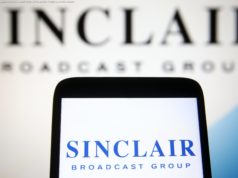Tariffs will make it harder to defuse a credit bomb without choking off growth.
The start of trade hostilities between the U. S. and China accentuates an important underlying theme in China’s own economy and the way it affects the world.
A big tussle is taking place within China that the leveling of tariffs by Washington and Beijing can only aggravate. That struggle is the effort by China to slow credit significantly: Enough to squeeze the shadow banking industry and rein in debt at state-run firms, but not so much that it causes a slump in overall growth.
Quicktake China Debt Bomb
Getting the balance right is tricky. Few countries manage to pull off soft landings, and trade conflict makes the task even trickier. China’s size means its domestic choices ricochet beyond its shores. If ever there was a test of China’s readiness and willingness to be a global economic leader and not just a big economy, this is it.
There are signs that China is worried by the risk of too great a slowdown and is starting to tweak its monetary policy. The People’s Bank of China declined to follow the Federal Reserve’s increase in interest rates last month, contrary to the predictions of many economists. Then on June 24, the PBOC said it would lower the amount of cash some lenders must hold as reserves.
For the better part of two years, China has been tapping the brakes on its $12 trillion economy. While gross domestic product grew almost 7 percent last year, the expansion is forecast to slow to about 6 percent over the next couple of years. That’s still solid, but because China is the world’s largest manufacturer and biggest exporter, and because it accounts for more than a third of global economic growth, the slackening matters. It’s showing up in weaker euro-zone growth and a slide in South Korean exports. All before the first shots were fired Friday by U. S. President Donald Trump, to which China has responded.
Quicktake Weapons of Trade War
The trade war will be another factor weighing on China as its expansion slows. Industrial production and retail sales fell short of forecasts in May while investment in fixed assets like factories, roads, power plants and the like had its worst start to the year since data began to be published in 1999.
The meshing of the domestic and international challenges was perfectly illustrated by the cut in reserve requirements. While it was announced on June 24, the reduction was timed to take effect on July 5, the eve of Trump’s imposition of the first $34 billion in tariffs on imports from China. The sequencing links the step to trade without explicitly saying so.
The easing was designed to achieve two things. Five hundred billion yuan ($75 billion) was unlocked for big banks to facilitate debt-for-equity swaps, which can reduce debt and help spruce up balance sheets. Another 200 billion was freed for smaller lenders to help small businesses. The PBOC was at pains to emphasize that this wasn’t a vanilla-flavored loosening of policy.
The central bank said it will « keep implementing prudent and neutral monetary policy, and create a favorable monetary and financial environment for high quality development and supply-side reform. » Translation: We aren’t reversing course (yet), but we are alert to the risks and want to take out a bit of insurance. There’s little prospect China will roll back on its tough overall line, given that President Xi Jinping has cited financial risks as a « critical battle, » according to Hayden Briscoe of UBS Asset Management.
China is right to tackle debt. Although China’s economy can seem like a juggernaut, few things would threaten economic and, therefore, political stability as much as a banking crisis. An all-out trade war would increase the cost of credit tightening. That’s quite a needle to thread.
To contact the author of this story: Daniel Moss at dmoss@bloomberg.net
To contact the editor responsible for this story: Jonathan Landman at jlandman4@bloomberg.net






